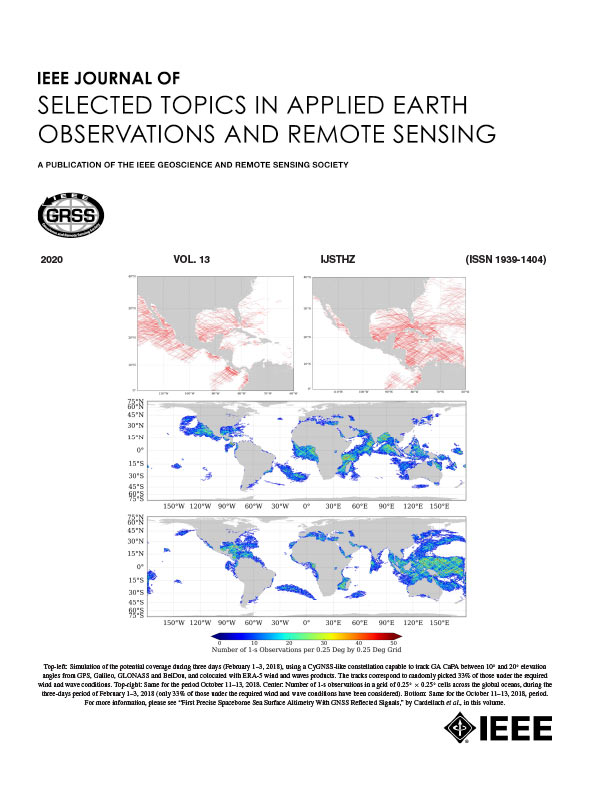Enhancing Hyperspectral Images Compressive Sensing Reconstruction With Smooth Low-Rankness Joint Gradient Sparsity
IF 4.7
2区 地球科学
Q1 ENGINEERING, ELECTRICAL & ELECTRONIC
IEEE Journal of Selected Topics in Applied Earth Observations and Remote Sensing
Pub Date : 2025-06-19
DOI:10.1109/JSTARS.2025.3580668
引用次数: 0
Abstract
The application of compressive sensing (CS) theory in hyperspectral images (HSI) reconstruction has been validated. The key to model-based reconstruction methods lies in effectively integrating prior knowledge of HSI. However, capturing multiple prior knowledge means that multiple regularization terms need to be set, which not only increases the complexity of the model, but also reduces its stability. In this article, a model based on smooth low-rank joint gradient sparsity is proposed to enhance the capability of HSI compressed sensing reconstruction. First, we propose a new model called the smooth spatial-spectral low-rank model (SSLR). Unlike most current models that treat the low-rankness and local smoothness of HSI as two separate regularization terms, SSLR uses only one regularization term. In addition, the use of 2-D gradient images introduces spatial–spectral correlation, while the constraint of Tucker rank allows for a more comprehensive capture of low-rank information across spatial and spectral dimensions. At the same time, to address the shortcomings of SSLR in capturing spatial features and sparsity, we design the multidimensional coupled gradient sparsity model to extract these features. The combination of 1-D spatial gradient images with a 2-D spatial-spectral gradient image fully captures the gradient sparsity across multiple dimensions. In addition, it obtains the rich spatial structure information of HSI. The superiority of the proposed model is demonstrated through comparative experiments conducted on three datasets.基于光滑低秩度联合梯度稀疏度增强高光谱图像压缩感知重构
实验验证了压缩感知理论在高光谱图像重建中的应用。基于模型的重构方法的关键在于有效整合HSI的先验知识。然而,捕获多个先验知识意味着需要设置多个正则化项,这不仅增加了模型的复杂性,而且降低了模型的稳定性。本文提出了一种基于光滑低秩联合梯度稀疏度的HSI压缩感知重构模型。首先,我们提出了一种新的平滑空间光谱低秩模型(SSLR)。与目前大多数将HSI的低秩和局部平滑作为两个独立的正则化项的模型不同,SSLR只使用一个正则化项。此外,二维梯度图像的使用引入了空间-光谱相关性,而塔克秩的约束允许更全面地捕获跨空间和光谱维度的低秩信息。同时,针对SSLR在空间特征捕获和稀疏性方面的不足,设计了多维耦合梯度稀疏性模型来提取空间特征。将一维空间梯度图像与二维空间光谱梯度图像相结合,充分捕获了多个维度上的梯度稀疏性。此外,它还获得了丰富的HSI空间结构信息。在三个数据集上进行了对比实验,证明了该模型的优越性。
本文章由计算机程序翻译,如有差异,请以英文原文为准。
求助全文
约1分钟内获得全文
求助全文
来源期刊
CiteScore
9.30
自引率
10.90%
发文量
563
审稿时长
4.7 months
期刊介绍:
The IEEE Journal of Selected Topics in Applied Earth Observations and Remote Sensing addresses the growing field of applications in Earth observations and remote sensing, and also provides a venue for the rapidly expanding special issues that are being sponsored by the IEEE Geosciences and Remote Sensing Society. The journal draws upon the experience of the highly successful “IEEE Transactions on Geoscience and Remote Sensing” and provide a complementary medium for the wide range of topics in applied earth observations. The ‘Applications’ areas encompasses the societal benefit areas of the Global Earth Observations Systems of Systems (GEOSS) program. Through deliberations over two years, ministers from 50 countries agreed to identify nine areas where Earth observation could positively impact the quality of life and health of their respective countries. Some of these are areas not traditionally addressed in the IEEE context. These include biodiversity, health and climate. Yet it is the skill sets of IEEE members, in areas such as observations, communications, computers, signal processing, standards and ocean engineering, that form the technical underpinnings of GEOSS. Thus, the Journal attracts a broad range of interests that serves both present members in new ways and expands the IEEE visibility into new areas.

 求助内容:
求助内容: 应助结果提醒方式:
应助结果提醒方式:


